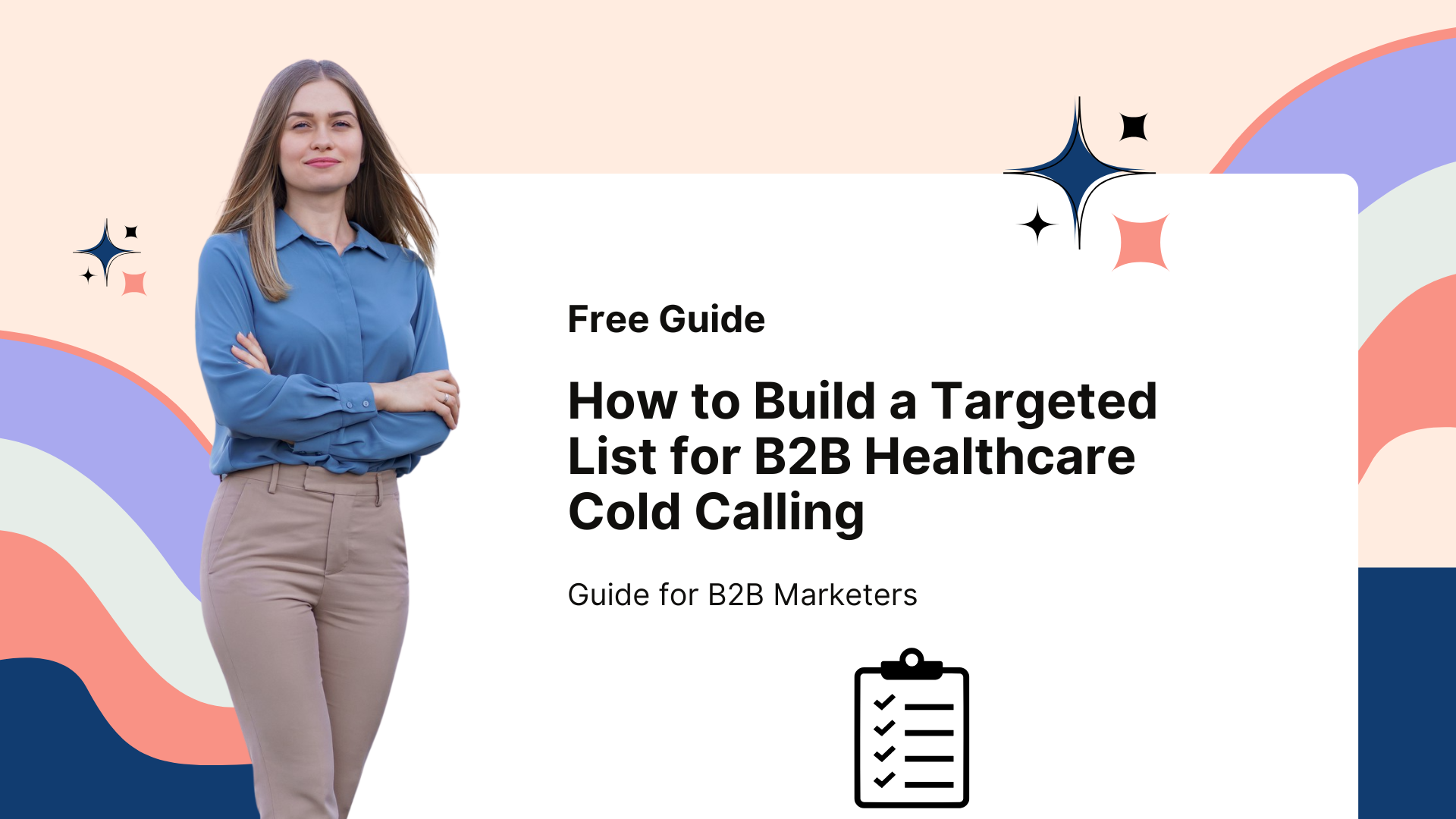Cold calling in healthcare marketing involves reaching out to healthcare professionals, such as doctors, nurses, and decision-makers, to introduce products or services that may benefit them.

TABLE OF CONTENTS
By now, you’re well aware that having a targeted list of potential buyers is the backbone of any successful cold calling campaign. But building that list? That’s where the magic happens.
To truly connect with healthcare professionals, whether it’s doctors, surgeons, or high-level decision-makers, you need a strategy that’s sharp, strategic, and data-driven. Without it, your outreach is nothing but a shot in the dark.
If you’re looking to build a targeted email list, this guide will help you build a strategy that maximizes your cold calling success.
1. Why Targeted Lists Matter in Healthcare Cold Calling ?

Cold calling in healthcare can be a powerful tool for connecting with the right people. But without a targeted list, your outreach can become vague and generic. Here’s why having a targeted list is important:
1.1. Increase Conversion Rates
With a targeted email list, you can focus on reaching the right decision-makers in healthcare. This precision increases your chances of conversion since you’re connecting with individuals who are more likely to be interested in your product or service.
1.2. Improved Personalization
A targeted healthcare contacts allows you to customize your messaging based on the recipient’s role, specialty, or location. Personalization not only grabs attention but also enhances trust and engagement, leading to more productive conversations.
1.3. Time and Resource Efficiency
Instead of wasting time on unqualified leads, a targeted email list ensures that every outreach effort counts. You can concentrate on prospects that align with your ideal customer profile, maximizing the value of your time and marketing budget.
1.4. Shorter Sales Cycle
With a focused list, you can engage with highly relevant contacts right away, leading to faster responses and quicker follow-ups. This shortens the sales cycle, moving prospects through your funnel with more efficiency.
1.5. Better Segmentation
A targeted healthcare email database enables you to segment your contacts based on specific criteria like practice type, geographic location, or even purchasing behavior. This segmentation lets you craft more relevant campaigns and messaging for each group, improving the overall effectiveness of your outreach.
1.6. Increased ROI
By focusing on high-value leads, you ensure that your efforts are more likely to result in meaningful interactions, reducing wasted spend on low-conversion prospects. This boosts your overall return on investment.
1.7. Compliance and Accuracy
Targeted email lists often come with verified, up-to-date information that complies with healthcare regulations, such as GDPR. This ensures you’re not only reaching the right people but also adhering to legal standards.
2. Key Factors for Building a Targeted List in Healthcare
When crafting your list, several key factors ensure that you’re reaching the decision-makers who matter most to your product or service.
2.1. Define Your Ideal Target Audience
Before you even start building your list, you need to define who you’re trying to reach. Here are some criteria you need to know:
- Specialty: Doctors, surgeons, and nurses have specific areas of expertise. Identify which specialties are most relevant to your service.
- Position: Are you targeting frontline healthcare professionals or higher-level executives like CEOs or hospital decision-makers?
- Location: Whether you’re targeting healthcare professionals in specific regions or global markets, narrowing down location helps focus efforts.
- Hospital Size and Type: Focus on hospitals, clinics, or healthcare networks that are aligned with your offerings.
2.2. Leverage the Right Data Sources
Finding high-quality data is the cornerstone of building a targeted list. Not all data sources are equal. Here’s where you can get the best information:
- Reputable Database Providers: MedicoLeads specializing in the healthcare sector. With over 40+ customizable filters, you can access detailed information on healthcare professionals, nurses, decision-makers, and healthcare industry leaders.
- Publicly Available Data: You can also look for publicly available contact info from healthcare directories and associations, but these often have gaps.
- Industry Events & Conferences: Information from attendees of healthcare conferences and expos can be a goldmine for contacts.
Ready to build your targeted list for healthcare cold calling?
Explore MedicoLeads customizable filters to create a database that aligns with your marketing goals and boosts your outreach strategy.
Click here to get started!2.3. Choose Relevant Data Attributes
When purchasing a targeted list, ensure that the provider offers the ability to filter data based on the following attributes:
- Job Title: Focus on C-suite executives (e.g., CEOs, CFOs), department heads, healthcare decision-makers, and physicians.
- Healthcare Specialty: Whether you’re targeting surgeons, general practitioners, or specialists like cardiologists or dermatologists, this is key for personalization.
- Location: Geographic location can be essential if you’re targeting specific regions or countries. Whether you need a nationwide or local outreach, this filter can save time.
- Practice Type: Differentiate between hospitals, private practices, academic institutions, and medical research centers.
- Professional Certifications: Filter for specific credentials, certifications, or affiliations that are important for your outreach.
3. Building Your List: Step-by-Step Process
Once you’ve identified your ideal targets and selected the appropriate filters, it’s time to begin building the list.
3.1. Start With Broad Filters, Then Narrow Down
- Initial Filters: Start broad, using filters like job title and healthcare type. Then narrow it down by specialty, location, and size of the organization.
- Prioritize Key Decision-Makers: Focus on those with the authority to make purchasing decisions. These could be C-level executives, department heads, or medical directors.
3.2. Cleanse and Verify Data
- Data Accuracy: Verify the accuracy of contact details such as email addresses, phone numbers, and names. A list with outdated or incorrect data is wasted effort.
- Cross-Check with Secondary Sources: Use LinkedIn or other professional networks to validate the contact details and roles of potential leads.
3.3. Segment Your List for Better Engagement
Once you have your list, segmentation is key to increasing your cold calling success.
- By Specialty: Create different lists based on medical specialties to ensure you are speaking their language and addressing specific pain points.
- By Practice Size: Tailor your pitch for smaller private practices vs. large hospitals or healthcare networks.
- By Decision-Maker Type: Customize your messaging for different decision-makers, as their priorities and pain points will differ.
4. Best Practices for Cold Calling Healthcare Professionals
Having a targeted list is just the first step. The next is reaching out in a way that resonates with healthcare professionals.
4.1. Craft a Personalized Message
Healthcare professionals are busy. To get their attention, your cold call or email should be:
- Personalized: Referencing their specific role, specialty, or pain points shows that you’ve done your research.
- Relevant: Offer solutions that align with their immediate needs and concerns. Don’t oversell; solve a problem.
- Concise: Time is precious. Keep your message clear and to the point.
4.2. Respect Their Time
When cold calling, always be mindful of their schedules. Calling at the right time is crucial. Avoid calling during busy hours, such as early mornings or lunch breaks.
4.3. Segment and Prioritize Your List
It’s essential to segment your contact list based on factors like specialty, role, and decision-making authority. This allows you to tailor your message to the specific needs of different groups—whether it’s a surgeon, CEO, or healthcare administrator. Prioritizing high-value leads ensures that you reach the most relevant decision-makers first.
4.4. Keep Your List Updated and Compliant
A successful cold calling campaign relies on accurate and current data. Regularly update your list to remove outdated contacts and ensure you’re targeting active professionals. Additionally, ensure your data complies with regulations such as GDPR and Can-Spam, HIPAA to avoid legal issues and establish trust with your prospects.
4.5. Follow-Up Strategically
If the first call doesn’t result in a meeting, don’t give up. A well-timed follow-up email or another call can help keep the conversation going.
4.6. Leverage Technology for Efficiency
Use CRM tools, automated outreach systems, and advanced data analytics to streamline your cold calling efforts. Technology can help you manage your list more efficiently, track engagement, and analyze responses.
By integrating technology into your strategy, you gain a strategic advantage that enables more personalized and effective outreach.
Final Thoughts
Building a targeted list for cold calling in 2025 is all about precision. With the right medical leads providers, such and a structured approach to segmentation, you can create a list that maximizes your outreach efforts.
By focusing on the right people at the right time and personalizing your outreach, your cold calling efforts will be more effective, helping you drive meaningful conversations and convert leads into clients.
Unlock the power of a perfectly targeted healthcare list!
With MedicoLeads’ customizable filters, you can create a tailored database that drives results and accelerates your cold calling strategy. Get started now and connect with the right prospects!
FAQ
How do I build a targeted list for cold calling healthcare professionals?
To build a targeted list, you should segment contacts by specialty, job title, location, and organization size. Using a database provider like MedicoLeads can help refine your search with customizable filters.
How do I reach decision-makers in healthcare?
Focus on high-level roles such as CEOs, department heads, and medical directors. Use filters to target specific positions and ensure you’re speaking to someone with purchasing power.
When is the best time to cold call healthcare professionals?
The best time to call is typically mid-morning or mid-afternoon, avoiding early mornings, lunchtime, and late afternoons when healthcare professionals are busiest.
How do I personalize my cold call pitch?
Start by researching the professional’s role and specialty, then tailor your message to address their specific pain points. Personalization makes your outreach more relevant and increases the chance of engagement.
What should I avoid when cold calling healthcare professionals?
Avoid being too pushy or too vague. Be respectful of their time, avoid jargon, and ensure your message is clear, relevant, and solution-oriented.
How can I follow up after a cold call?
Follow up with a polite email summarizing the key points from your call. If you didn’t reach them, try scheduling a follow-up call at a time that works for them.
How can I ensure my cold calling list stays compliant?
Make sure your data collection practices comply with regulations like GDPR and HIPAA. Regularly update your list to remove outdated contacts and ensure you’re reaching active professionals.
Can technology help improve cold calling success?
Yes! CRM tools, automated outreach systems, and analytics software can streamline your cold calling process, helping you manage your list, track engagement, and improve your outreach strategy.
How can I measure the success of my cold calling campaign?
Track metrics such as call connect rates, conversion rates, responses, and meetings scheduled. These key performance indicators (KPIs) will help you assess and refine your approach.
Contact Us

